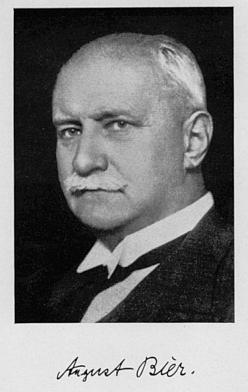August Karl Gustav Bier
(1861 - 1949)


August Bier was a versatile, innovative and, in his last years, extremely unorthodox surgeon. In 1898, Bier pioneered spinal anaesthesia. He was influenced by the introduction of the lumbar puncture as a diagnostic and therapeutic technique by his colleague at Kiel, Heinrich Irenaeus Quincke (1842-1922).As a young doctor, Bier helped manage the transition at Kiel from antiseptic to aseptic surgery. He was inspired by the work of Professor Ernst von Bergmann (1836-1907), to whose chair in Berlin he succeeded after short professorships in Griefswald and Bonn.
In 1908, Bier pioneered the use of intravenous procaine analgesia. He also introduced the "tin helmet" into the German Army in World War One.
After the War, Bier became more eccentric. He promoted callisthenics and the "Studiengemeinschaft für tierärztliche Homöopathie" [Study Group for Veterinary Homeopathy], founded in 1936 to investigate the alleged systemic effects of homeopathic drugs.
The number of homeopathically-oriented veterinarians has always remained small. Supporters of Samuel Hahnemann (1755-1843), the German physician who created homeopathy, were among the assortment of hydropaths, herbalists, devotees of Rush's "heroic medicine", and diverse naturopaths who opposed the "unnatural" innovation of painless operations via surgical anaesthesia in mid-19th century America.
HOME
Search
Resources
Snapshots
August Bier
Utopian Surgery
Refs and Further Reading
Anaesthesia and Anaesthetics